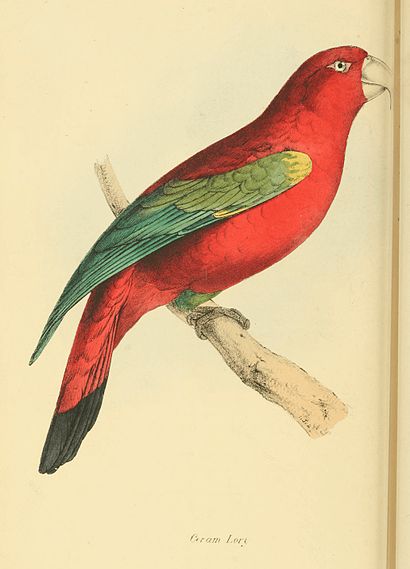Zoological Illustrations Series II/Plate 12
Ceram Lory
LORIUS garrulus.
Ceram Lory.
Family Psittacidæ.
Generic Character.
Bill moderate, compressed, end of the upper mandible, within, entirely smooth; under mandible lengthened, conic; the tip entire. Legs stout; Tail moderate, rounded or graduated; the feathers broad, their tips obtuse. Nob.
Specific Character.
Scarlet: wings green, shoulders yellow, half of the tail bluish black.
Psittacus garrulus. Lin. 144. Kuhl. Cons. Psit. p. 41. No. 56.
Le Lori-Noira. Buffon. Sonn. 27. p. 126. Pl. Enl. 216.
Le Perroquet Lori Nouara. Levail. 2. pl. 96.
Scarlet Lory. Edw. pl. 172.
Le Lory de Ceram. Briss. Orn. 4. 215.
The popular name of Lories has long been given to those Parrots, peculiar to the continent and islands of India, whose brilliant red plumage forms a strong contrast to the green colour which generally pervades this family. The southern limits of their distribution do not extend to Australia, but much of their general structure is transferred to the Lory-Parrakeets, forming the modern genus Trichoglossus; this latter group being diffused over the remaining islands of the great Pacific Ocean.
The Ceram Lory, from being well known, and exhibiting the prominent characters of its tribe, is a correct type of the genus. Its length is about eleven inches. The general colour is rich scarlet, with the wings and thighs green: the bend of the shoulder, (and sometimes a spot on the back,) is yellow. Tail graduated, the lower half of the feathers deep blackish green, glossed with blue. Inhabits the Molucca Islands.
Notwithstanding the attention recently bestowed in characterizing the groups of this family, the most important external peculiarity of Lorius and Trichoglossus has been overlooked. In these birds, that part of the roof of the under mandible which projects beyond the lower, is generally thin, and always perfectly smooth: a weakness of structure which renders it impossible for these parrots to feed upon hard substances; and betrays their frugivorous and suctorial nature, by indications perceptible to every one.

